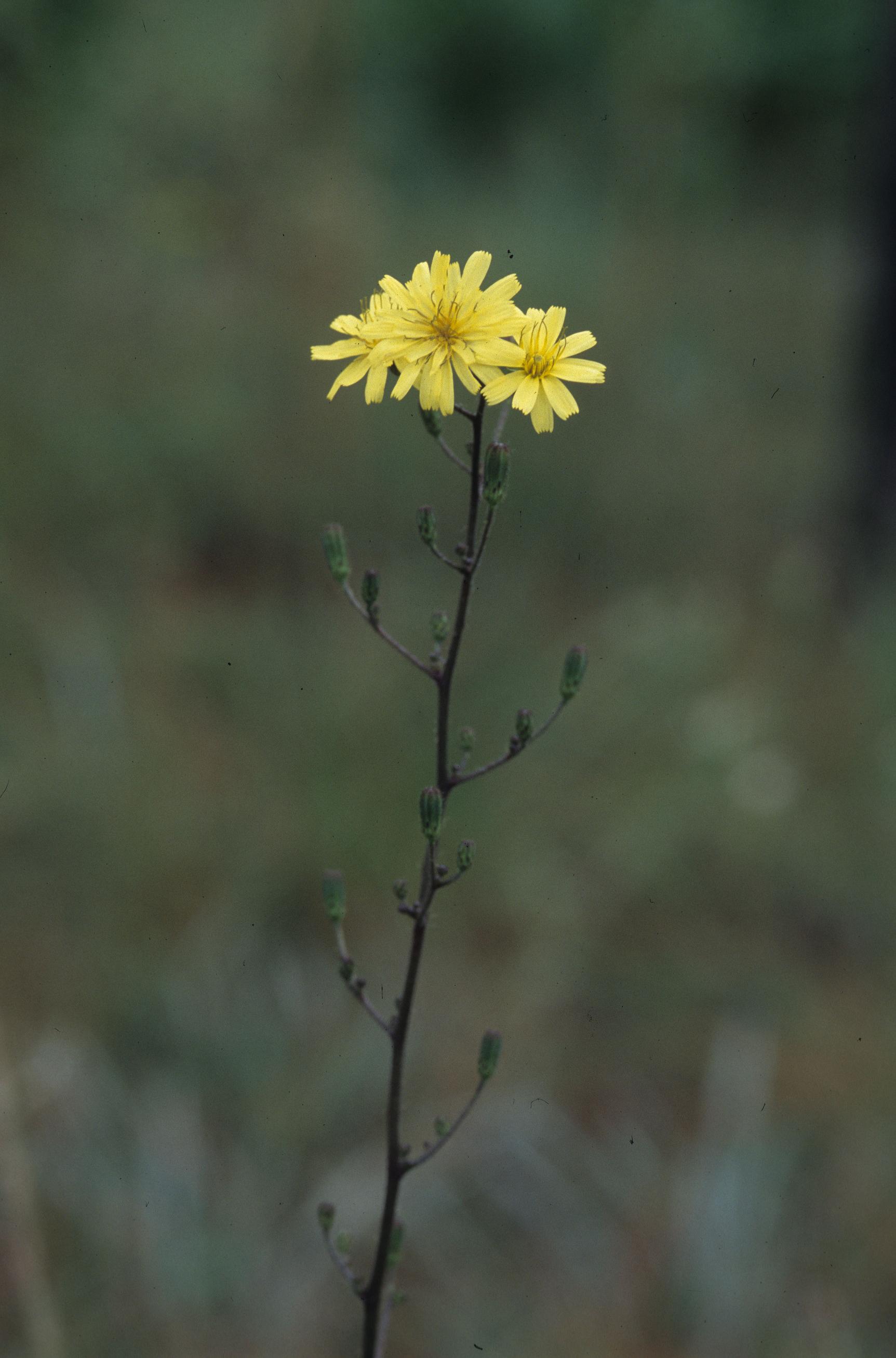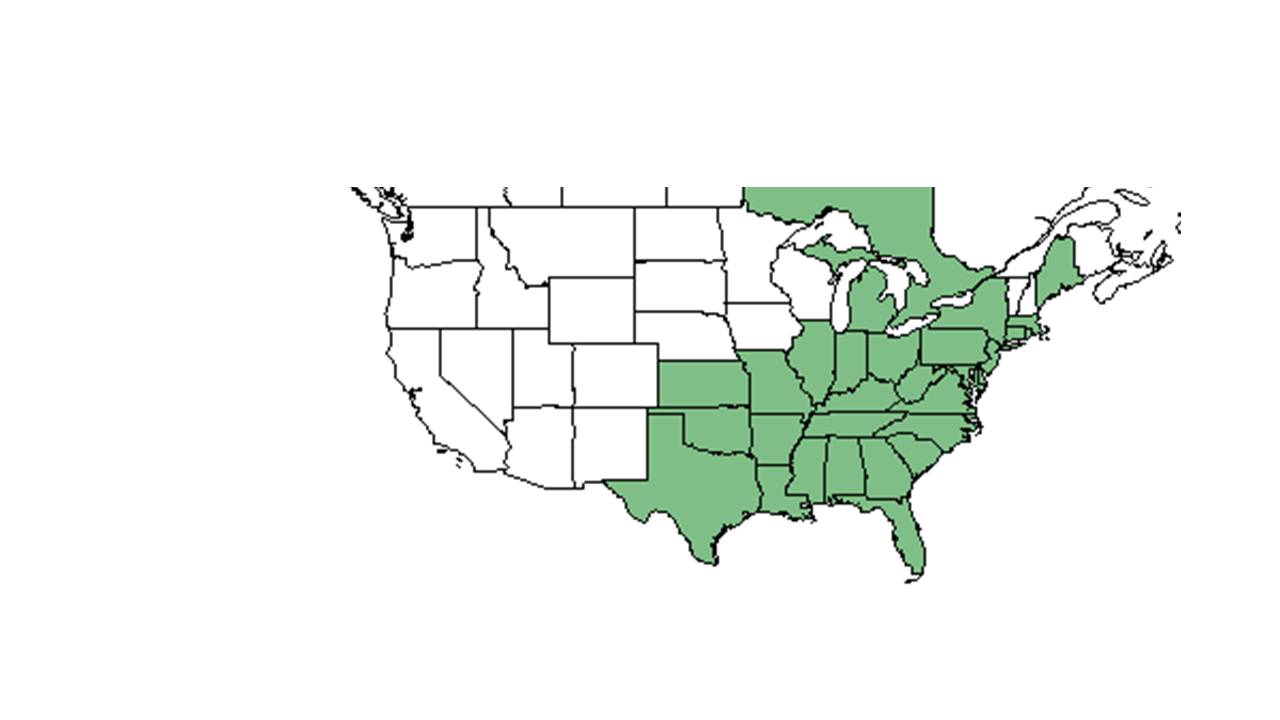Hieracium gronovii
| Hieracium gronovii | |
|---|---|

| |
| Photo was taken by Gil Nelson | |
| Scientific classification | |
| Kingdom: | Plantae |
| Division: | Magnoliophyta - Flowering plants |
| Class: | Magnoliopsida – Dicotyledons |
| Order: | Asterales |
| Family: | Asteraceae ⁄ Compositae |
| Genus: | Hieracium |
| Species: | H. gronovii |
| Binomial name | |
| Hieracium gronovii L. | |

| |
| Natural range of Hieracium gronovii from USDA NRCS Plants Database. | |
Common name: Queen-devil; Beaked hawkweed
Contents
Taxonomic notes
Synonym: Hieracium gronovii L. var. foliosum Michx. USDA NRCS Plants Database
Description
A description of Hieracium gronovii is provided in The Flora of North America. Hieracium gronovii is a perennial herbaceous species.
Distribution
Hieracium gronovii is distributed from Massachusetts west to Michigan and Kansas south to central peninsular Florida and Texas.[1] It is also native to the Canadian province of Ontario.[2]
Ecology
Habitat
Generally, H. gronovii can be found in dry forests, sandhills, roadsides, and various woodland margins.[1] It occurs in moist or dry sandy soils, from dry loamy sand to moist sandy peat, dry sand, and moist sandy loam. It also seems to prefer light conditions ranging from semi-shade to full sun. This species can occur in a range of native and disturbed habitats. Native habitat includes mixed oak-pine sandhills, pine-scrub oak-palmetto communities, longleaf pine savannas, turkey oak barrens, open mixed hardwood forests, and sandy areas bordering cypress ponds and hillside bogs. However, it can also be found in disturbed areas including roadsides, old fields, open annually mowed pineland, power line corridors, and drainage ditches.[3] This species was shown to decrease in frequency in response to the control of woody species.[4]
Associated species include Quercus margaretta, Pinus palustris, Aristida stricta, Serenoa repens, Crotalaria spectabilis, Lechea mucronata, Desmodium tortuosum, Rubus cuneifolius, Heterotheca subaxillaris, Andropogon virginicus, Paspalum notatum, Solidago altissima, and Eupatorium compositifolium.[3]
Phenology
This species generally flowers from July until November.[1] H. gronovii has been observed flowering in January, February, and July through November, and fruiting in May. [3][5]
Seed dispersal
This species is thought to be dispersed by wind. [6]
Seed bank and germination
Several short-lived perennial forbs also have a seed bank persistent for at least several years.[7] It has been seen to germinate from the seed bank at early successional 1 and 2 year old field sites.[8]
Fire ecology
It has been found in habitats maintained by frequent fire.[3] This species has been shown to benefit most from summer burn regiments rather than winter or spring burn regiments.[9] As well, it is most frequent in low fire return intervals.[10]
Pollination
The following Hymenoptera families and species were observed visiting flowers of Hieracium gronovii at Archbold Biological Station. [11]
Halictidae: Augochloropsis sumptuosa, Halictus poeyi, Lasioglossum coreopsis
Megachilidae: Anthidiellum perplexum
Other pollinators of Hieracium gronovii in the Hymenoptera order include Dialictus coreopsis, Halictus ligatus, Anthidium maculifrons, Megachile breuis pseudobrevis, and M. georgica, M. mendica, Ceratina dupla, C. mikmaqi, Augochlora pura, Augochlorella aurata, Agapostemon splendens, Lasioglossum bruneri, L. macoupinense, L. pectorale, L. pilosum, and Heriades variolosus.[12][13]
Use by animals
H. aculeatus consists of approximately 2-5% of the diet for various large mammals and terrestrial birds.[14] It is known to be eaten by white-tailed deer.[15]
Conservation and management
Hieracium gronovii is listed as possible extirpated by the Maine Department of Conservation, Natural Areas Program. As well, the genus Hieracium is listed as a class C noxious weed for non-native species by the state of Washington.[2] It is also imperiled in Kansas and Ontario.[16]
Cultivation and restoration
Photo Gallery
References and notes
- ↑ 1.0 1.1 1.2 Weakley, A. S. (2015). Flora of the Southern and Mid-Atlantic States. Chapel Hill, NC, University of North Carolina Herbarium.
- ↑ 2.0 2.1 USDA, NRCS. (2016). The PLANTS Database (http://plants.usda.gov, 22 May 2019). National Plant Data Team, Greensboro, NC 27401-4901 USA.
- ↑ 3.0 3.1 3.2 3.3 Florida State University Robert K. Godfrey Herbarium database. URL: http://herbarium.bio.fsu.edu. Last accessed: June 2014. Collectors: Loran C. Anderson, Wilson Baker, Robert Blaisdell, Chris Cooksey, George R. Cooley, R. A. Davidson, Richard J. Eaton, J. P. Gillespie, Robert K. Godfrey, S. R. Hill, Richard D. Houk, Ed Keppner, Lisa Keppner, Gary R. Knight, R. Komarek, R. Kral, Robert L. Lazor, Sidney McDaniel, Richard S. Mitchell, John Morrill John B. Nelson, R. A. Norris, R. E. Perdue Jr., James D. Ray Jr., Paul L. Redfearn Jr., Cecil R. Slaughter, Bian Tan, R. F. Thorne, and Jean W. Wooten. States and Counties: Florida: Alachua, Bay, Calhoun, Clay, Columbia, Dade, Franklin, Gulf, Hernando, Jackson, Jefferson, Leon, Levy, Liberty, Madison, Nassau, Okaloosa, Osceola, Putnam, Santa Rosa, Taylor, and Wakulla. Georgia: Grady and Thomas.
- ↑ Harrington, T. B. (2011). "Overstory and understory relationships in longleaf pine plantations 14 years after thinning and woody control." Canadian Journal of Forest Research 41: 2301-2314.
- ↑ Nelson, G. PanFlora: Plant data for the eastern United States with emphasis on the Southeastern Coastal Plains, Florida, and the Florida Panhandle. www.gilnelson.com/PanFlora/ Accessed: 12 DEC 2016
- ↑ Kirkman, L. Katherine. Unpublished database of seed dispersal mode of plants found in Coastal Plain longleaf pine-grasslands of the Jones Ecological Research Center, Georgia.
- ↑ Platt, W. J., S. M. Carr, et al. (2006). "Pine savanna overstorey influences on ground-cover biodiversity." Applied Vegetation Science 9: 37-50.
- ↑ Oosting, H. J. and M. E. Humphreys (1940). "Buried viable seeds in a successional series of old field and forest soils." Bulletin of the Torrey Botanical Club 67(4): 253-273.
- ↑ Kush, J. S., et al. (2000). Understory plant community response to season of burn in natural longleaf pine forests. Proceedings 21st Tall Timbers Fire Ecology Conference. Fire and forest ecology: innovative silviculture & vegetation management, Tallahassee, FL, Tall Timbers Research, Inc.
- ↑ Mehlman, D. W. (1992). "Effects of fire on plant community composition of North Florida second growth pineland." Bulletin of the Torrey Botanical Club 119(4): 376-383.
- ↑ Deyrup, M.A. and N.D. 2015. Database of observations of Hymenoptera visitations to flowers of plants on Archbold Biological Station, Florida, USA.
- ↑ Deyrup, M. J. E., and Beth Norden (2002). "The diversity and floral hosts of bees at the Archbold Biological Station, Florida (Hymenoptera: Apoidea)." Insecta mundi 16(1-3).
- ↑ Grundel, R., et al. (2011). "A survey of bees (Hymenoptera: Apoidea) of the Indiana Dunes and Northwest Indiana, USA." Journal of the Kansas Entomological Society 84(2): 105-138.
- ↑ Miller, J.H., and K.V. Miller. 1999. Forest plants of the southeast and their wildlife uses. Southern Weed Science Society.
- ↑ Atwood, E. L. (1941). "White-tailed deer foods of the United States." The Journal of Wildlife Management 5(3): 314-332.
- ↑ [[1]] NatureServe Explorer. Accessed: May 22, 2019